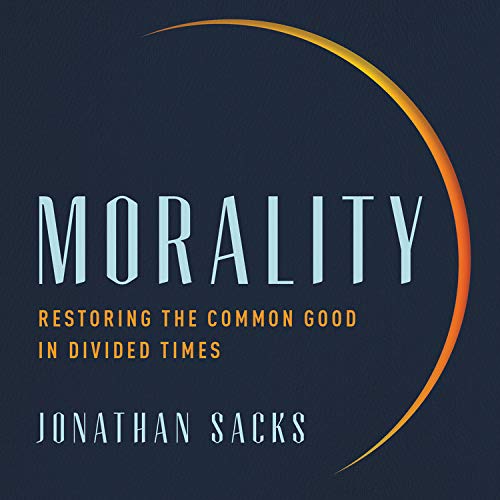Morality: Restoring the Common Good in Divided Times audiobook
Hi, are you looking for Morality: Restoring the Common Good in Divided Times audiobook? If yes, you are in the right place! ✅ scroll down to Audio player section bellow, you will find the audio of this book. Right below are top 5 reviews and comments from audiences for this book. Hope you love it!!!.

Review #1
Morality: Restoring the Common Good in Divided Times audiobook free
I tend to listen to Rabbi Sacks’ books on Audible. His calm, kind, and assuring voice is great on road trips but I find it to be downright restorative as an American living in the year that is 2020. His writing is an island of sanity in a culture gone mad, very much like the Bible.
Three chapters into this book I had to stop and order the hardback so I could highlight rather than continue taking so many notes. If you are seeking greater understanding of the world at large, want help identifying the traps you yourself have fallen into, and are seeking hope for what you can do to at least get yourself and your family out of the line of fire, this is the book for you. It’s not a casual read. I can’t imagine someone reading it and not placing it on their reference shelf to return to time and time again as years go by. There is age old wisdom in this book. I’m grateful to Rabbit Sacks for writing it.
Review #2
Morality: Restoring the Common Good in Divided Times audiobook streamming online
The prolific Rabbi Lord Jonathan Sacks new 380-page visionary book Morality: Restoring the Common Good in Divided Times (New York: Basic Books, 2020) is an extraordinarily well-written tour de force.
In terms of genre, Rabbi Sacks new 2020 visionary book is basically a sweeping jeremiad a fast-paced blitzkrieg of sharp critiques, peppered with perceptive discussions of various Western philosophers (most notably Friedrich Nietzsche [1844-1900]) and social commentators (most notably Alexis de Tocqueville [1805-1859]), including numerous contemporary social critics (most notably Harvards Robert D. Putnam [born in 1941] and Harvards Mary Ann Glendon [born in 1938]). See the index in Rabbi Sacks book for specific page references to each of these authors.
However, in terms of substance, Rabbi Sacks new 2020 visionary book nicely complements Pope Francis new 43,000-word visionary social encyclical on social friendship titled Fratelli Tutti, which the Vatican released on October 3, 2020 and which I read just before I read Rabbi Sacks new book. The pope explicitly addresses his new social encyclical not only to practicing Catholics around the world, but also to persons of good will around the world because he assumes that persons of good will are concerned about the common good, which Rabbi Sacks explicitly refers to in the subtitle of his new book (see esp. pages 1, 17, 97, 120, 121, 122, 141, 156, 188, 193, 257, and 324). In general, Roman Catholic social teaching is concerned with the common good.
But Rabbi Sacks (born in 1948) holds a Ph.D. in political philosophy. In one of the many autobiographical notes scattered throughout his new book, he mentions that the atheist Bernard Williams (1929-2003) served as the director of his doctoral dissertation (page 211; also see 169). For Rabbi Sacks generous praise for Williams 1993 book Shame and Necessity (Berkeley, Los Angeles, Oxford: University of California Press), see pages 80 and 211.
However, the Italo-Argentine Pope Francis (born in 1936), the first Jesuit pope, did not complete the doctorate he began in theology. Nevertheless, both Pope Francis new visionary social encyclical and Rabbi Sacks new visionary book are timely as we collectively struggle to work for the common good during the Covid-19 worldwide pandemic.
But Rabbi Sacks is head and shoulders above Pope Francis as a vivid and cogent prose stylist. However, I admit that as a prose stylist, Rabbi Sacks has few equals he is not only an effective writer, but an effective communicator and formidable conversationalist.
Now, just as Pope Francis new 2020 visionary social encyclical on social friendship carries forward his thought from his 2015 visionary eco-encyclical, so too Rabbi Sacks new 2020 visionary book carries forward and expands his thought in three earlier visionary books:
(1) To Heal a Fractured World: The Ethics of Responsibility (New York: Schocken Books, 2005);
(2) The Home We Build Together: Recreating Society (New York: Continuum, 2007);
(3) Essays on Ethics: A Weekly Reading of the Jewish Bible (Jerusalem, Israel; New Milford, Connecticut: Maggid Books and the Orthodox Union, 2016).
However, those three visionary books are comparatively sedate compared to Rabbi Sacks new 2020 visionary book. (So are Pope Francis 2015 and 2020 visionary social encyclicals.)
The prolific Rabbi Sacks discusses the Hebrew Bible in his series of eight books on Covenant and Conversation, one of which is his 2016 book of essays on ethics mentioned above. In any event, the ancient Hebrew idea of covenant serves as the springboard for the visionary orientation of Rabbi Sacks new 2020 book.
As for what Rabbi Sacks refers to as economics and the arenas of economic competition, as distinct from the arenas of cooperation (pages 17-18, 252-253, 256, 262, and 283), I would like to mention the thought of the American Jesuit Renaissance specialist and cultural historian Walter J. Ong (1912-2003; Ph.D. in English, Harvard University, 1955). In his 1981 book Fighting for Life: Contest, Sexuality, and Consciousness (Ithaca and London: Cornell University Press), the published version of his 1979 Messenger Lectures at Cornell University, Father Ong describes the competitive spirit as agonistic.
However, even though Ong does not happen to advert explicitly to what Plato and Aristotle refer to as thumos (or thymos), what Ong refers to as the agonistic spirit of the human psyche is equivalent to what Plato and Aristotle refer to as the part of the human psyche (or soul) known in Greek as thumos (or thymos).
For better or worse, our American experiment in representative democracy includes electing political representatives, in which elections there are usually two or more candidates standing for each position, which thereby triggers the competitive spirit in the political arenas.
Nevertheless, Rabbi Sacks engages his own agonistic spirit in his new 2020 visionary book as he calls for people of good will, as Pope Francis might put it, to help build up and strengthen the common good on various levels of society and in various arenas in which cooperation needs to be cultivated as we cope with the worldwide Covid-19 pandemic.
As Rabbi Sacks explains, the idea of covenant has a historical place in American history: As for politics, covenant, the key concept of the Hebrew Bible, has been part of American political culture since the first Puritan settlers. Their first formal act was the Mayflower Pact of 1620: We whose names are underwritten . . . solemnly and mutually in the presence of God, and of one another, covenant and combine our selves together in a civill body politick. Aboard the Arbella in 1630, John Winthrop similarly declared, We are entered into covenant with Him [God] for this work.
Covenant has been an underlying strand of American political thought ever since. Its most famous expression is the opening phrase of the preamble to the American Constitution: We, the people. That phrase used five times in Barack Obamas second inaugural address is pure covenant terminology. It speaks of sovereignty lying in the hands not of a ruler or government but of the people themselves, conceived as a community of equals who have accepted collective responsibility for their common destiny and fate (page 283; ellipsis in Sacks book; material in square brackets in Sacks book; Sacks has quoted the spelling in the historical document).
In addition, Rabbi Sacks says, unprecedentedly, in the Hebrew Bible the human person as such became Gods significant other. Each individual was in the image and likeness of God. The intimacy of this relationship gave rise to a new kind of morality based not on justice only but also on love: Love the Lord your God with all your heart, all your soul, and all your might, Love your neighbor as yourself, and Love the stranger, because you know what it feels like to be a stranger (page 281; also see 70).
Rabbi Sacks also says, This vision [of the social order] gave rise to the unique world of the Hebrew prophets figures like Elijah, Elisha, Amos, Hosea, Isaiah, and Jeremiah who spoke truth to power, criticized kings, and told the people endlessly to practice justice and compassion, righteousness and love (page 282).
That much is true enough about the ancient Hebrew prophets. However, I would argue that when you subscribe to their vision of the social order, you will tend to catastrophize (in Albert Ellis well-known terminology), as Rabbi Sacks tends to, at times, in his sweeping jeremiad.
For example, in his zeal for his sweeping jeremiad, Rabbi Sacks says, As of 2019, there were 5.1 billion owners of mobile phones [disclosure: I am not one of them], 4.3 billion user of the internet [disclosure: I am one of them], and 3.4 billion users of social media [disclosure: I am not one of them]. . . . Never have more people been more widely, quickly, and easily connected. This is a revolution that will prove at least as transformative as the (Western) invention of printing in the mid-fifteenth century (page 48).
Rabbi Sacks is referring to the emergence of the Gutenberg printing press in the mid-1450s, which contributed immeasurably to the Protestant Reformation and the development of vernacular Bibles.
Now, Ongs massively researched book Ramus, Method, and the Decay of dialogue: From the Art of Discourse to the Art of Reason (Cambridge, Massachusetts: Harvard University Press) is a pioneering study of the transformative invention of the Gutenberg printing press. What Ong refers to as the Art of Reason is the transformation in Western culture known as the Age of Reason or as the Enlightenment.
In Ongs 1958 book, he works with the aural-to-visual shift involved in the shift from the ancient and medieval Art of Discourse, including the Jewish tradition of what Rabbi Sacks refers to as argument for the sake of heaven (pages 186-188 and 191-192), to the modern Art of Reason (see the index in Ongs book for aural-to-visual shift for specific page references).
But mobile phones, like land-line phones, accentuate the aural dimension, but also include the visual dimension in their screens as do the internet and social media. In other words, what we today refer to as screen time carries forward the visual emphasis of printed pages after the Gutenberg printing press emerged in the mid-1450s but the typographic text on screens today is oftentimes accompanied by images.
Now, Rabbi Sacks also discusses our hunter-gatherer ancestors (pages 69, 128, 146, 280, and 281). No doubt they pioneered the kind of oral-aural communication (in Ongs terminology) that Rabbi sacks celebrates as the celebrated ancient Hebrew covenant with their monotheistic deity (also known as God).
Now, in between our pre-historic hunter-gatherer ancestors and our ancient Hebrew cultural ancestors, our human ancestors invented phonetic alphabetic writing systems which emphasized the visual (in Ongs terminology) and which is why we have the anthology of written documents known collectively as the Hebrew Bible. Rabbi Sacks says, Morality begins with kin (page 257).
For a perceptive study of our pre-historic human ancestors sense of time as cyclic, see Mircea Eliades book The Myth of the Eternal Return, translated from the French by Willard R. Trask (New York: Pantheon Books, 1954; orig. French ed., 1949). Rabbi Sacks discusses cyclic time briefly on pages 250 and 282.
Ong discusses Eliades work extensively in both of his books published in 1967: (1) In the Human Grain: Further Explorations of Contemporary Culture (New York: Macmillan; London: Collier-Macmillan, see the index for specific page references to Eliade) and (2) The Presence of the Word: Some Prolegomena for Cultural and Religious History (New Haven and London: Yale University Press, see the index for specific page references to Eliade), the expanded version of Ongs 1964 Terry Lectures at Yale University.
Incidentally, in Ongs book In the Human Grain (pages 156-159 and 162-163), Ong quotes and discusses the same extended passage from Nietzsche that Rabbi Sacks quotes and briefly discusses (page 244). Because Rabbi Sacks new book is titled Morality, perhaps I should point out here that in Ongs book he does include his essay titled American Culture and Morality (pages 164-188).
Now, Rabbi Sacks also says, Bernard Williams, my doctoral supervisor, in his outstanding [1993] book Shame and Necessity [mentioned above], makes another important distinction. The most primitive experiences of shame are connected with sight and being seen, but it has been interestingly suggested that guilt is rooted in hearing, the sound in oneself of the voice of judgment [in Ongs terminology the oral-aural dimension]; it [guilt] is the moral sentiment of the word (Sacks, page 231; quoted from Williams, page 89).
But presumably this interior moral sentiment was also present in our pre-historic hunter-gatherer ancestors, at least in kernel form, even though they lived in what Rabbi Sacks refers to as a tradition-directed (in David Riesmans terminology) shame cultures, not in the inner-directed guilt culture pioneered by the ancient Hebrews (page 272).
In Ongs 1957 book Frontiers in American Catholicism: Essays on Ideology and Culture (New York: Macmillan, pages vii and 39), he discusses David Riesmans 1950 book The Lonely Crowd: A Study of the Changing American Character (New Haven: Yale University Press).
In addition, Rabbi Sacks says that the story of Adam and Eve in the book of Genesis is about the respective roles in the moral life of seeing and hearing. The story begins with Adam and Eve naked and unashamed. Note that this is the first reference to shame in the Bible, albeit in its absence. The serpent tells the woman that if she eats from the fruit her eyes will be opened (Gen. 3:5). Note the significance of this. They had not been blind until now. In what respect will their eyes be opened? This seems to be an explicit reference to a mode of moral judgment, knowing good and evil, that has to do with sight rather than sound. The woman looks at the tree and sees that it is intensely desirable to the eyes [as all of our contemporary screen devices appear to be to us?] (page 211).
For a cautionary account of how images may appear intensely desirable to the eyes, see the American Jesuit William F. Lynchs 1959 book The Image Industries (New York: Sheed and Ward).
Now, Rabbi Sacks also says, The couple eat, their eyes are opened, they know that they are naked, and they seek to cover their nakedness. Every element of this is visual from the beginning. . . . The point, however, is that Adam and Eve have become utterly sight oriented. That is why they think you can hide. That is why they experience a voice walking as if it were itself something to be seen rather than heard (pages 211-212).
For a cogent account of the aural-to-visual shift in ancient Greek culture, see the classicist Eric A. Havelocks 1963 book Preface to Plato (Cambridge, Massachusetts: Belknap Press of Harvard University Press) a work that Ong never tired of referring to.
Next, Rabbi Sacks says, Judaism, with its belief in an invisible God who created the world with words, is an attempt to base the moral life on something other than public opinion, appearance, honor, and shame. As God tells Samuel, The Lord does not look at things people look at. People look at outward appearance, but the Lord looks at the heart (1Sam. 16:7). Hence the ethic of the divine word; hence the key term in Judaism, Shema: hear or listen. Hence the importance of the inner voice, of conscience, of guilt rather than shame; of repentance, not rejection; of forgiveness rather than appeasement; of integrity of the individual regardless of his or her deeds (page 212).
In conclusion, if you have your heart set on writing a jeremiad, this is the way to do it pull out all the stops and have it, but be sure to include your prescription for addressing the problems you describe. I have no doubt that Rabbi Sacks heart is in the right place. However, I admit that I am not sure that the English-speaking world needs a second jeremiad as comprehensive as his anytime soon.
Review #3
Audiobook Morality: Restoring the Common Good in Divided Times by Jonathan Sacks
In this book, Rabbi Jonathan Sacks achieves something rare: simplicity amid complexity. While his writing is nuanced and draws on sociological, biological, philosophical, psychological, historical, and theological themes the reader is not left adrift in a quagmire of academic jargon or led down the side canyons of narrow scholarship. Instead, he skillfully weaves together diverse intellectual threads with the loom of wisdom, producing a tapestry of thought that is relevant, timely, and applicable.
His thesis is compelling: If our deeply divided society is to heal and thrive then the current culture of radical individualism must be tempered by a morality that creates a community bound together by the common good. We must move from the narrow vision of freedom as a pursuit to achieve our own selfish ends to an expansive vision of freedom that elevates all people in society through the moral imperatives of self-restraint, solidarity, social responsibility, reciprocal altruism, and genuine human kindness. We must retreat from the single-minded pursuit of self-interest embodied in a contractual worldview and embrace the rich moral framework of a people bound together by a covenant. In short, We must transcend I.
Review #4
Audio Morality: Restoring the Common Good in Divided Times narrated by Jonathan Sacks
Another wonderful erudition.from Rabbi Sacks of the ultimate challenge of the 21st century. He explains, puts into context, gives suggested remedies, dire.predictions and ultimately ends on the most Jewish of all themes–hope, optimism and a.path.toward a.full.remedy.
Bravo!!!
Review #5
Free audio Morality: Restoring the Common Good in Divided Times – in the audio player below
One of the best books I have read in a long time and a very good diagnosis of many of the ills facing our society. Rabbi Sacks combines timeless wisdom with data driven insight, wrapped in a package of inspiring prose.
Galaxyaudiobook Member Benefit
- Able to comment
- List watched audiobooks
- List favorite audiobooks
GalaxyAudiobook audio player
If you see any issue, please report to [email protected] , we will fix it as soon as possible .






